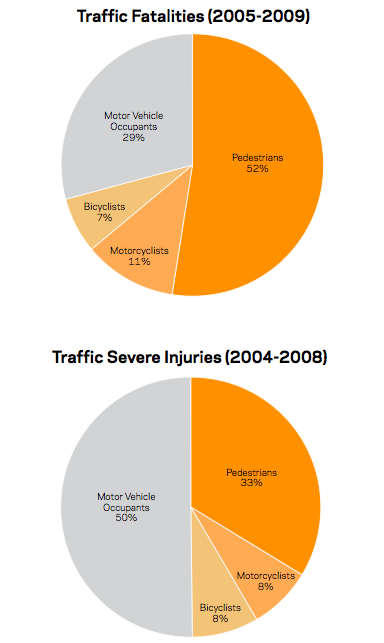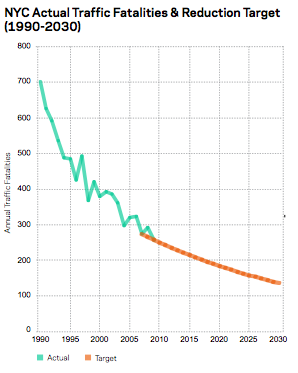Action Plan Ups NYC’s Commitment to Ped Safety, But Is NYPD on Board?
"Safety isn’t just about statistics," NYCDOT Commissioner Janette Sadik-Khan said yesterday while announcing her agency’s new Pedestrian Safety Study and Action Plan. "It’s not just about a dot on a map."
When you’re talking about saving lives, preventing life-altering injuries, and creating city streets where New Yorkers feel safe walking or biking, the full impact is impossible to quantify. But to make effective progress on all those fronts, DOT is grounding its work in thorough data.
Using an analysis of more than 7,000 crashes that caused serious pedestrian injuries or deaths, DOT will focus its safety efforts on the most dangerous locations and behaviors. The action plan commits to specific strategies to re-design and re-engineer streets most prone to traffic violence. Whether NYPD enforcement will also adjust to clamp down on the deadliest violations, however, remains uncertain.
The document released yesterday contains the sort of large-scale, in-depth analysis — what Transportation Alternatives has called "an epidemiological approach" — that pedestrian safety advocates have been working toward for years. A comprehensive study of pedestrian deaths and injuries was mandated by Local Law 11, sponsored by Council Member Vincent Gentile, which passed in a unanimous vote in April, 2008. Speaker Christine Quinn emphasized that the law provides an
ongoing requirement to study and address pedestrian safety which will
continue to reap benefits in years to come.
 Pedestrians are at the greatest risk of death caused by NYC traffic. Image: NYCDOT
Pedestrians are at the greatest risk of death caused by NYC traffic. Image: NYCDOTOne thing that jumps out of the numbers is the general culpability of automobile drivers in causing crashes that seriously injure or kill pedestrians. Shockingly, more pedestrians were struck while crossing with the traffic signal than against it, though collisions were deadlier for pedestrians crossing against the light. The technical supplement to the study [PDF] identifies driver actions as the main cause in 78.5 percent of serious pedestrian crashes.
Overall, the top contributing factors included driver inattention, a cause of 36 percent of crashes that killed or seriously injured pedestrians, failure to yield, involved in 27 percent of such crashes, and high speeds, involved in 20 percent of such crashes. The findings echoed several similar patterns recorded in Killed by Automobile [PDF], the groundbreaking 1999 study of NYC pedestrian and cyclist crashes conducted by the non-profit Right-of-Way and safety advocate Charles Komanoff.
In detailing exactly how and where serious crashes occur, the safety study points toward a set of solutions. Manhattan’s streets were particularly deadly, with four times as many serious crashes per mile than the other four boroughs (though the victims of these crashes came from across New York and beyond). Within Manhattan, fatalities were overwhelmingly concentrated on major two-way streets, like Canal or 125th. These streets make up 12 percent of Manhattan’s road network, but 47 percent of the borough’s pedestrian fatalities happen on them. Accordingly, DOT has committed to building safety improvements at twenty intersections along these streets per year.
Similarly, DOT’s analysis shows that the greatest potential to reduce danger isn’t necessarily found at particular intersections, but along entire corridors. Eliminating serious injuries and fatalities at the 52 most dangerous intersections would only eliminate 3.5 percent of the citywide total, the report shows, but tackling the wide arterial roads that comprise 15 percent of the street network would address a full 60 percent of the worst crashes.
Finding that crashes involving left turns outnumbered crashes involving right turns, the report calls for a pilot program to “daylight” the left side of all intersections on one yet-to-be-determined Manhattan avenue, which would give pedestrians and motorists clearer views of each other by removing parking spaces. If the pilot successfully reduces injuries, it would be extended across Manhattan.
 Traffic fatalities have fallen 35 percent in New York City since 2001. Will pedestrian safety policies meet the city’s goal of reducing deaths to half the 2007 level by 2030? Image: NYCDOT
Traffic fatalities have fallen 35 percent in New York City since 2001. Will pedestrian safety policies meet the city’s goal of reducing deaths to half the 2007 level by 2030? Image: NYCDOTMoving forward, DOT plans to annually install safety improvements along 60 miles of the most dangerous streets, as identified by a new system to rank all intersections and corridors by the severity of injuries that occur there. At least 20 of those miles would be "intensive safety redesigns," altering the roadbed and lane configurations, while the rest might only change signaling, signage, and parking regulations.
Though Sadik-Khan asserted at the press conference that the department’s top priority is always safety, a detail inside the action plan suggests otherwise. When the action plan calls for implementing less intensive safety redesigns, those will take place "where full street redesigns are not feasible due to factors such as traffic volumes or geometric constraints." Moving cars will still win out, some of the time.
Noting that high speeds make crashes far more deadly, DOT also promised to reduce speeds in some parts of the city. "We can’t say this loudly or frequently enough," said Sadik-Khan. "Speeding kills." The department is currently looking for a residential neighborhood willing to participate in a pilot of New York’s first 20 mph speed zone. Additionally, Sadik-Khan reiterated the agency’s promise to increase the number of slow speed zones around schools from 25 to 75 this year, making a new pledge to add another 75 zones in 2011.
The proposals to reduce speeds garnered praise from street safety advocates. "20 mile per hour zones have proved immensely successful in London," said Transportation Alternatives’ Noah Budnick. "We think that’s a good start." But while streets are being redesigned one by one and 20 mph zones are being evaluated, he said, enforcement needs to fill the safety gap. "We need the police to start setting the tone," he said, "so people start obeying these critical parts of the law.”
The action plan includes a section on enforcement, but three of the four recommendations simply state that NYPD will continue their efforts to identify unlicensed drivers, target distracted drivers, and collect traffic data. The fourth contains the promise of a new strategy: an inter-agency collaboration between NYPD and DOT to target speeding along major corridors.
Yesterday’s press conference, though, set low expectations for change within the department. While Transportation Chief James Tuller attended the event, he did not speak. And when asked whether NYPD’s practices would change at all as a result of this report, Bloomberg replied that the department’s resources are "stretched thin" and that "they will continue to do what they’re doing."
Continuing to do what they’re doing, however, means continuing to issue traffic summonses without targeting pedestrian safety goals. For example, though the number of fatalities and crashes caused by failure to yield increased between 2005 and 2007, according to T.A.’s 2009 report, "Executive Order," the number of tickets handed out for failing to yield declined during that same period.
The enforcement measures outlined in the report are a step forward, wrote Komanoff in an email, but added that they amount to "barely a drop in the bucket in the face of chronic, ongoing, massive driver violations (speeding, failure to grant right-of-way, inattention, etc.), and traditional police indifference if not downright hostility to pedestrian rights."
More highlights from the safety study:
- Traffic crashes in New York City cost $4.29 billion annually, according to NYCDOT estimates, or around one percent of the the city’s economic output. Pedestrian crashes cost an estimated $1.38 billion.
- 80 percent of crashes that killed or seriously injured pedestrians involved male drivers, and men were twice as likely to die in a crash as were women.
- 79 percent of these serious crashes were caused by private vehicles, not taxis, trucks, or buses. Even so, during questions Bloomberg was pressed on reckless taxi drivers, and the mayor raised an interesting solution. "In other cities like Hong Kong, taxis have a light that goes on on top of the vehicle when you’re speeding," he said. "No one’s proposing that here, but it makes the police’s job easier."
- Because traffic kills young New Yorkers as well as old, its impact on the public health measure of "years of potential life lost" is very high: equivalent in the city to strokes and hypertension.
- In New York City, 74 percent of serious crashes involving pedestrians occur at intersections. Nationally, the number is reversed; 76 percent of those crashes occur at non-intersection locations.
- Bike lanes make pedestrians much safer. Controlling for other factors, DOT found that serious crashes on streets with bike lanes were 40 percent less deadly than on other streets.
- Some common contributors to dangerous streets are not as important in New York City. Alcohol was only involved in eight percent of fatal pedestrian crashes in New York; nationally, alcohol is involved in 13 percent of all such crashes. Only 8 percent of New York pedestrian fatalities involved a driver without a valid license; nationally, 18 percent of all fatal crashes involve unlicensed drivers. DOT found that only "a very small proportion" of pedestrian injuries stemmed from drivers running red lights.
- The tragedy of traffic deaths does not fall evenly across New York. While those with a high school education or less make up only 52 percent of the adult population in New York, they represent 70 percent of the city’s pedestrian fatalities.